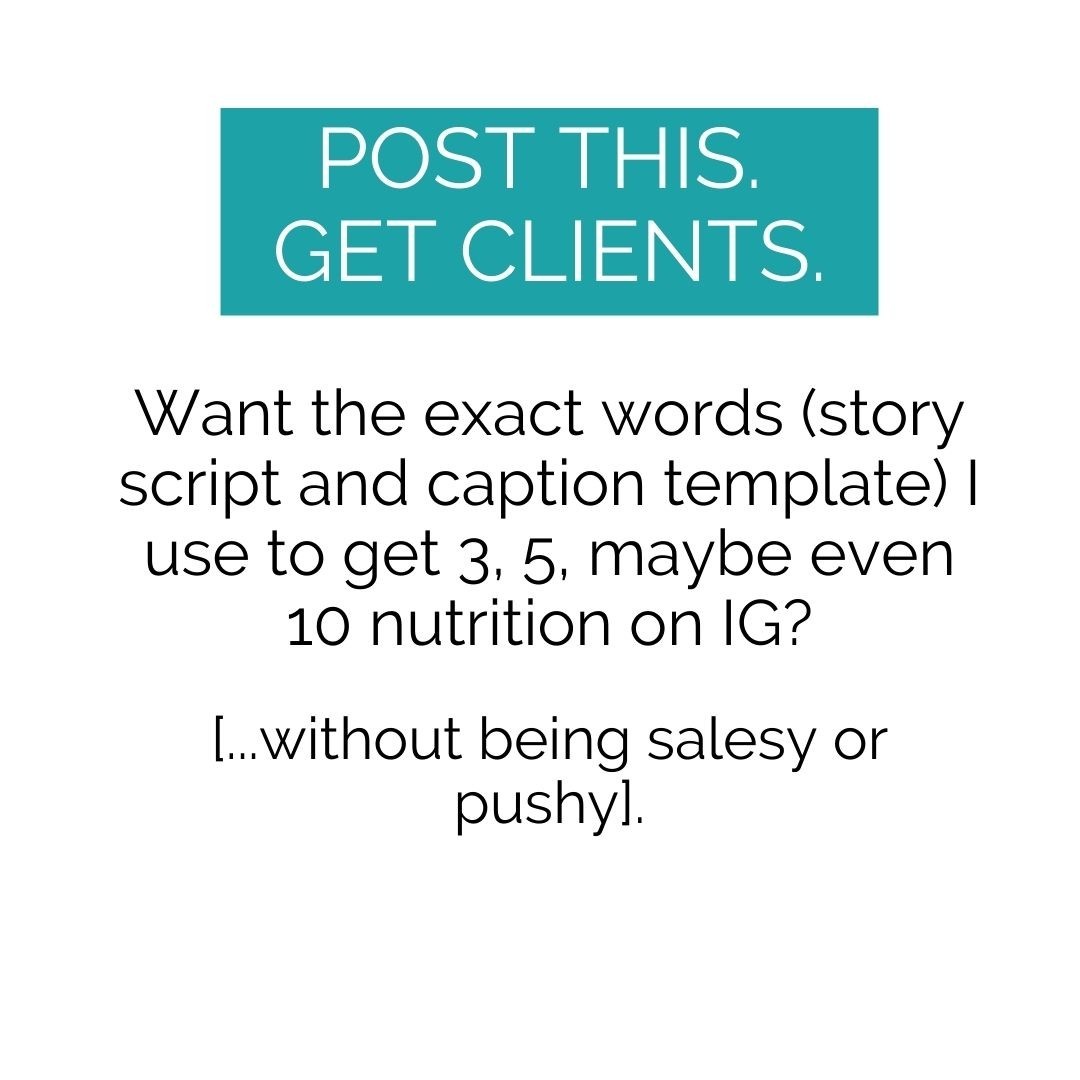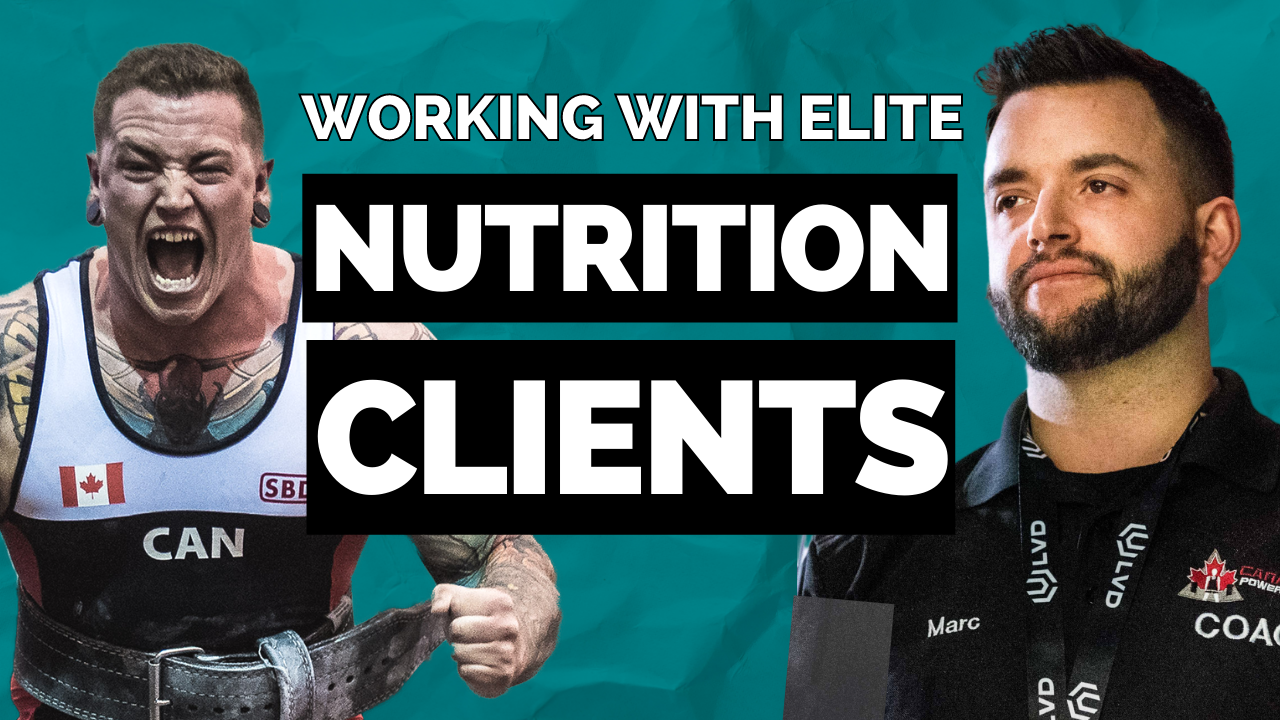Today, I want to share with you a case study on one of the strongest and most decorated powerlifters out there… Bryce Krawczyk.
There was even a time when Bryce wasn’t sure how to take things to next level. Something was holding home back, and if he didn’t fix it, his lifting career would be limited.
I managed Bryce’s nutrition from 2017 to 2019, and I’m going to unpack all the strategies we used.
Here’s what most nutrition coaches get WRONG about working with Top Level Nutrition clients like Bryce.
They treat them dramatically differently than everyone else.
When in reality, they benefit from coaching, in the same way, everyone else does.
Namely…
1. Nutrition Tracking
Like it or not, body composition has a big influence on the success of an athlete, especially strength athletes. The best way to manipulate body composition is to control for the big picture nutritional components that influence this process.
This means taking a closer look at calories or macronutrients
But then this is where most coaches go wrong…
2. Accountability
You may think since someone is so advanced in their development that they are super special…
BUT the thing elite athletes need more than anything else that is shared with all your clients: Accountability.
Having a coach check in with them and ensure they are sticking to what they need to do makes the world of difference.
If anything, this is WHY everyone would benefit from having a coach.
Especially athletes.
But what makes them a bit different and more challenging is the need for a….
3. Long Term Plan
The more advanced you get as an athlete the more important it is to have a long-term plan.
Without one, you really limit your long-term development mainly because you need to get specific and focused to reach the highest levels of your sport.
For strength athletes like Bryce, this means periodizing your nutrition into phases or blocks with a specific focus.
Over this two-year period working with Bryce, we had taken him all over two weight classes. Optimizing his body comp in his original weight class, then pushing the leanness. Finally filling out the weight class where he would be most competitive.
Here’s what Bryce had to say about some of the big things that changed with his nutrition as we started working together.
“I think some of the big things for me were the increased accountability. I think being accountable myself worked for a while until it didn't anymore and then having to check in and knowing there would be somebody else that would be a little bit extra bummed if I messed up or whatever. So I think for me that was one of the biggest things and then having an idea of what to expect for you know like when I did things myself. I didn't really have like a long-term plan to be like okay we're going to bulk here, we're going to cut there, we're going to do this, and it will all line up with the competition. I just tried to make weight a couple of times and then pretty much bulked for like eight years” - Bryce Krawczyk
As a nutrition coach you need to set up a system to get clients results, but then realize they benefit from the same accountability and guidance as anyone else.
What is important though from a performance standpoint, is having a long-term plan that falls in line with their competition schedule and sets them up to perform their best.
I’m going to show you how Bryce mastered his nutrition and the strategies, planning and mindset he’s taken to take his lifting and performance to the next level
If you’ve ever been curious about how to work with a high-level athlete like Bryce and manage things like
- long-term nutrition planning,
- short term weight manipulation,
- behaviour and psychology,
- finally weight class strategy
Buckle up because I'm giving you a detailed journey through the three main phases of our work together.

Here’s how Bryce’s nutrition habits looked before we started working together.
- Protein intake is on the low end of the optimal range (1.7 g/kg), with big swings day to day
- Inconsistent food intake on a day-to-day basis
- Overall energy intake around maintenance, but without a periodized focus
- like many involved in resistance training, Bryce knew what to do, but lacked adherence and direction
As you can see, even though he’s an elite athlete Bryce’s nutritional habits were similar to many of my clients.
Once I got an idea of how things looked, I took into account his normal food habits, assessed how things looked objectively (calories and macronutrients) and set a plan with his weight classes in reference.
Then through the years, we started to focus on different phases with different intents to make sure his nutrition reflected his goals, with the overall aim to make him the most competitive strength athlete possible.
Let’s go through these phases:
Phase 1: Optimizing a weight class (2017)
In 2017, we started the process of optimizing Bryce’s body weight and body composition within the 105 kg class.
The first meet we prepared for was the 2017 CPU Nationals in Quebec.
Bryce was getting into equipped lifting and planned to do both contests on back-to-back days (Friday, March 17/Saturday, March 18).
Which as a coach to super hard to plan for.
So here’s what the FOCUS was in this timeframe.
With most powerlifting clients, the goal is to fill in the weight class and be slightly above in the effort to make the athlete bigger than the competition
With all else equal, the most muscular athlete wins, so this is a viable strategy in weight class sports…
But, with the back-to-back weigh-ins, one of the contests was equipped (meaning he was wearing supportive gear). I decided to get him safely in the weight class so he could eat and drink throughout and just as important, his gear fitted similarly in training to how it would on game day.
So, the PLAN was for the 5 weeks leading up to the contest we put him on a slight deficit and took him from the week of the contest.
And this was the OUTCOME.
Even with the weight loss, Bryce performed well in training and generally felt better.
Probably due to the increases in protein and food quality.
We actually got a bit ahead of the process and we are able to ramp his carbs up leading into the week of the meet.
Bryce was able to make weight both times (103.8 first, 103.1 raw second) and win both weight classes with 898 and 797.5 kg totals respectively. Personal Best (PB) in the equipped meet.
And this was Bryce’s focus for an entire year
Bryce was able to maintain between 105 - 109 kg (0-2.5% above weight class) for a full 18 months leading into some other premier events: IPF Equipped World Championships 2017, CPU Nationals 2018, and IPF Classic World Championships 2018 all in the 105 kg class.
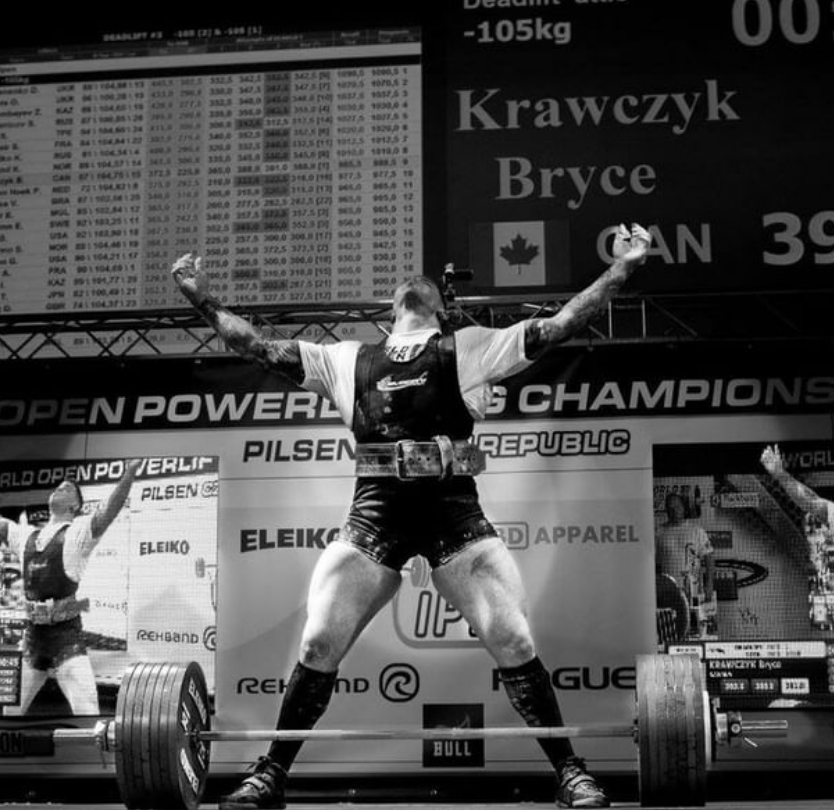
His energy intake ranged between ~3300 - 3600 kcal for the most part, but one of the biggest changes was his dedication to protein intake (~230-250 grams) down the stretch.
Additionally, there were two local meets and the Arnold Classic invitational during this time where we decided to lift as is (~108 kg) to meet qualifiers or focus solely on performance without short-term weight manipulations.
Phase 2: Pushing The Leanness
The intent is always important - sometimes it means maintaining your weight, but it can also mean changing focus to fat loss or muscle gain (and subsequent weight changes) to improve as a strength athlete.
After the 2018 Classic Worlds, Bryce wanted a change so after a bunch of beers we decided to change his FOCUS by going into a fat loss phase to re-optimize his body comp.
Actually, the original plan was a bit more elaborate.
But the original plan was to move Connor Lutz, Bryce and myself into the same training/housing compound (called “the brodome”)
Where we’d document all of us getting as shredded as possible.
No one was on board with the idea so we just went about it normally.

The PLAN was to push for ~100 kg from 108-109 over a 3-4 month period.
Based on the past phases, I knew a ~10% calorie drop over this period should do the trick.
The OUTCOME was Bryce transitioned to eating lower levels of food - focusing on food volume and hitting his protein targets.
His energy intake got as low as ~2700 kcal per day, as the weight got closer to 102-103, then past that point, we were able to start ramping things up as he got more active and weight dropped as low as 100 kg while eating more (3200-3500 kcal).

What we see here is that strength athletes benefit from phases - most of their time should be spent above maintenance energy intake so they can perform well and gain muscle, but brief periods of cutting, in this case, 10-14 weeks, can help break up the monotony and re-sensitize their hormones
But then the focus switched back to competition and finding the place where Bryce would be most competitive.
Phase 3: Joining the Big Boys
After the cut, the focus changed to working his food intake up to fill 105 kg back in and he lifted at the 2019 CPU Nationals in the 105 kg class.
At a certain point, the best way for a strength athlete to improve their strength is to fill in a heavier weight class - so the decision was made to work up into the 120 kg class.
This was one part necessity - at a certain level, eating near maintenance levels would hinder the potential to get strong and hit some lifelong milestones.
But additionally, the competition level was more favourable in the -120 kg class at the International level.
So we decided to take the plunge and join the big boys (read not biggest boys) a weight class up.
In most cases, quality weight (ie muscle) doesn’t go on as fast as less favourable weight (fat mass) comes off, so the plan was to we wanted to make the slow climb up to 115-116 so Bryce was near the top of the class, but given his deadlifting advantage could always tie competitors and come up on top (being one of the lighter competitors).
But, in my experience lifters don’t just hang out in the middle of the weight class.
For whatever reason, once you decide to go up, you just go up and 109 turns into 114 in what feels overnight.
Part of this is intended, but the other part is subconscious (more relaxed around tracking/controlling).
Gaining a bunch of weight isn’t as easy or fun as it sounds. Since we were a bit more relaxed around tracking (i.e taking 2-3 days off per week) we used a few strategies to keep Bryce moving in the right direction.
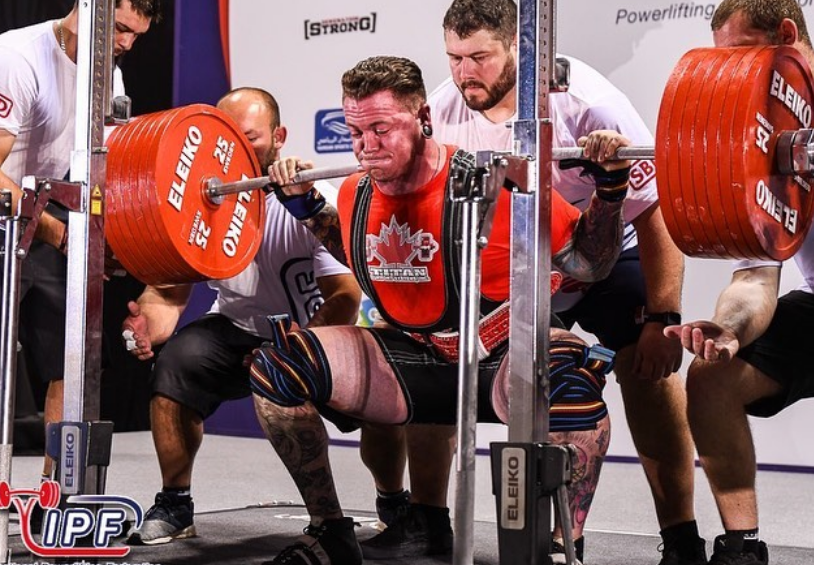
The first one was setting a basement level of calories - we always try to stick within ranges, but the “basement” is a better visual for most clients.
Don’t go under this, you need to make it here.
Thus the basement was set at 4,000 calories and Bryce knew to keep pushing he would need to get there each day. To me, the goal of consistency isn’t being perfect each day, but a bunch of good days all strung together. #nodaysunder4K
On the off days, his only goal was not to come back into his normal routine weighing any lighter. This set the intent for his eating.
Lastly, to eat 4000+ kcals each, you need to eat some less healthy food to get there (candy, higher fat meat). It left Bryce feeling rather sluggish and unwell, so we set some structure around food choices that would help improve his overall health and well-being. It looked like this:
- Include 1 serving of fruit or vegetable every time you eat
- Include 1 anti-inflammatory fat source every time you eat (minus pre-workout meals, just to help digestion).
Think nuts, seeds, trail mix, hummus, olive oil, coconut oil, fish etc.
This was a big game changer in the way Bryce viewed his nutrition.
The outcome of this was Bryce slowly filled in the 120 kg class on his way to some big lifts;
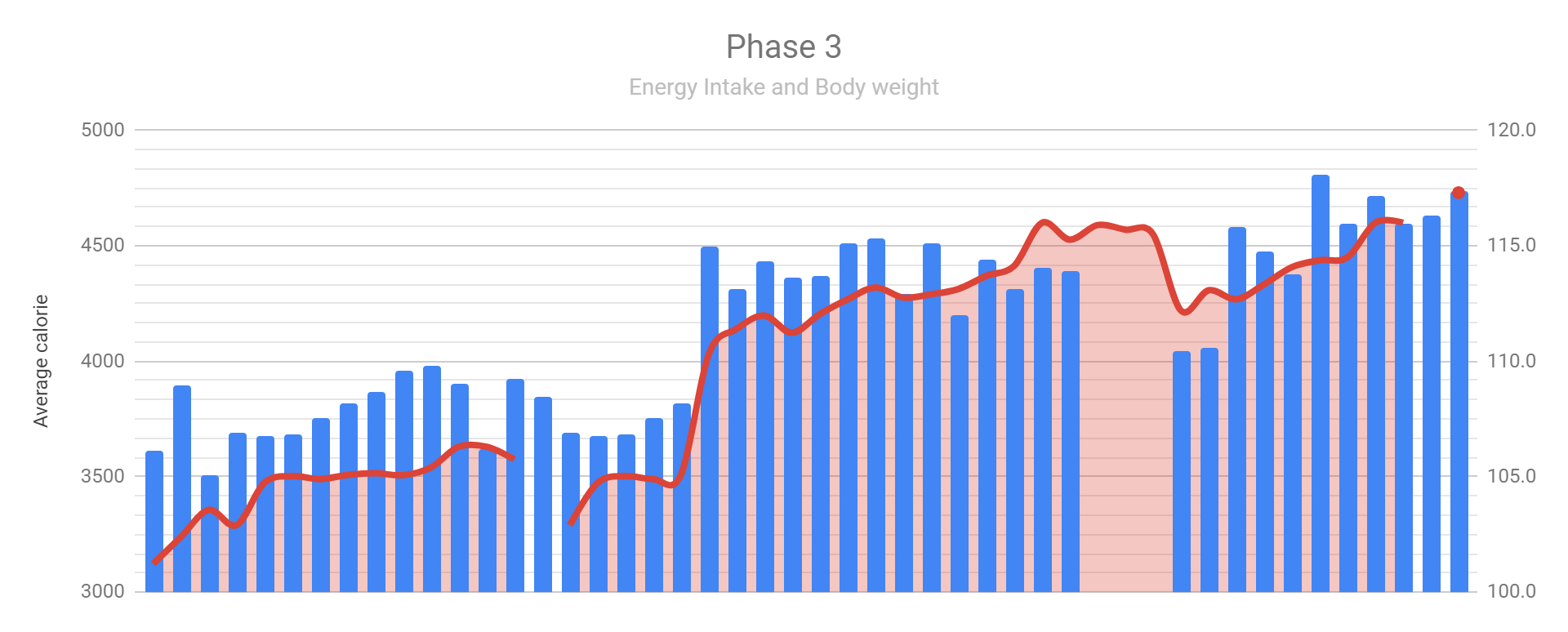
Here’s the deal: strength athletes benefit from phases. In this phase, we made the decision for Bryce to fill in 120 kg and it paid off for him as he continued to lift well on the international scene.
At a certain level, gaining weight isn’t any fun either. It’s a lot of work. Setting some structure around minimum food intake and making healthy choices strikes a balance between feeling good and gaining weight.
And those were the three main phases.
Working with anyone, let alone a high-calibre athlete like Bryce, for years as a nutrition coach is a privilege.
You get to put some long-term planning into action and flex your behavioural change muscles to keep things moving.
Some of the biggest lessons from my time with Bryce are:
- High-level athletes are just like anyone else - they thrive off accountability and guidance. But there’s always a time and place - there is a time to be lenient with less structure, and a time to dial it all in and push forward.
- At a certain level, strength athletes must focus on nutrition. Obviously, there are physical benefits (performance, recovery etc), but one of the biggest off-paper benefits of this is intention and focus - focusing on nutrition is important, but leaving no stone unturned. That builds certainty and confidence.
This is how you get results for top-level nutrition coaching clients.
As great as all these tips are, if you’re really serious about growing your nutrition coaching business. The next thing you’re going to want to do is to check out the link I have right here. Use the exact words in your new free social media script and you'll be working with high-level clients, in no time.
So make sure to check it out now and I’ll see you next time.
Post this. Get Clients.
Get new nutrition clients on Instagram in just 10-minutes a day using this simple script.
Download >>